Immerse yourself in Mysore’s captivating history and culture by exploring the iconic Mysore Palace, also known as the Amba Vilas Palace. Nestled at the heart of Mysore, this majestic palace beckons travellers with its unparalleled beauty and historical significance.
Tracing the Magnificent History of Mysore Palace (Amba Vilas Palace)
For centuries, the regal abode of the Wadeyar rulers stood as a testament to Mysore’s illustrious past. Serving as the bastion of the Wadeyar dynasty, who held allegiance to the Vijayanagar kings, the Palace boasts a legacy that spans ages. From 1399 until the dawn of 1947, with a brief interruption of 38 years under the rule of Hyder Ali and his son Tipu Sultan, the Wodeyars reigned over Mysore.
Historical records reveal that during the 14th century, the Wodeyars resided in a wooden structure surrounded by modest homes, forming a quaint cluster. 1638 a lightning strike ignited a transformation, with Kantirava Narasa Raja Wodeyar (1638-1659) overseeing the Palace’s reconstruction and expansion, adorning it with new pavilions.
The 18th century brought turbulent times as Mysore was entangled in conflicts with the Marathas, the British, and the Nizam of Golconda. The ensuing Anglo-Mysore Wars culminated in the fall of Tipu Sultan in 1799, leaving the British to redistribute territories to their allies.
Rising to the occasion was Krishnaraja Wodeyar IV, crowned king at the tender age of five. Upon maturity, his foremost endeavour was to resurrect the Palace of his forebears.

Yet, misfortune struck in 1897 when a raging fire engulfed the Palace during the wedding of Princess Jayalakshmanni. Undeterred, Queen Regent Maharani Vanivilasa Sannidhana (Maharani Kempananjammanni Devi) commissioned Henry Irwin to craft a new palace atop the ruins of the old one. Thus, Amba Vilas Palace was born.
Today, the glorious Mysore Palace stands tall as one of India’s most revered tourist attractions, drawing over six million visitors annually—a testament to its enduring allure and historical significance. It has etched its name in history alongside the Taj Mahal, captivating the hearts and imaginations of all who step within its storied walls.
Mysore Palace Architecture
The Mysore Palace is a magnificent building that blends together different architectural styles. It’s often referred to as Indo-Saracenic, which excitingly combines elements from Hindu, Muslim, Rajput, and Gothic designs.
Imagine a three-story building made of stone with beautiful marble roofs on top. A tall tower reaches an impressive 145 feet and has five floors. This grand Palace is surrounded by a big garden, and its exterior beauty is just a hint of the fantastic things you’ll find inside.
The building is made from grey granite, and it’s pretty impressive to look at. The fancy pink marble roofs on top catch your attention right away. When you look at the front of the Palace, you’ll see seven big arched doorways.
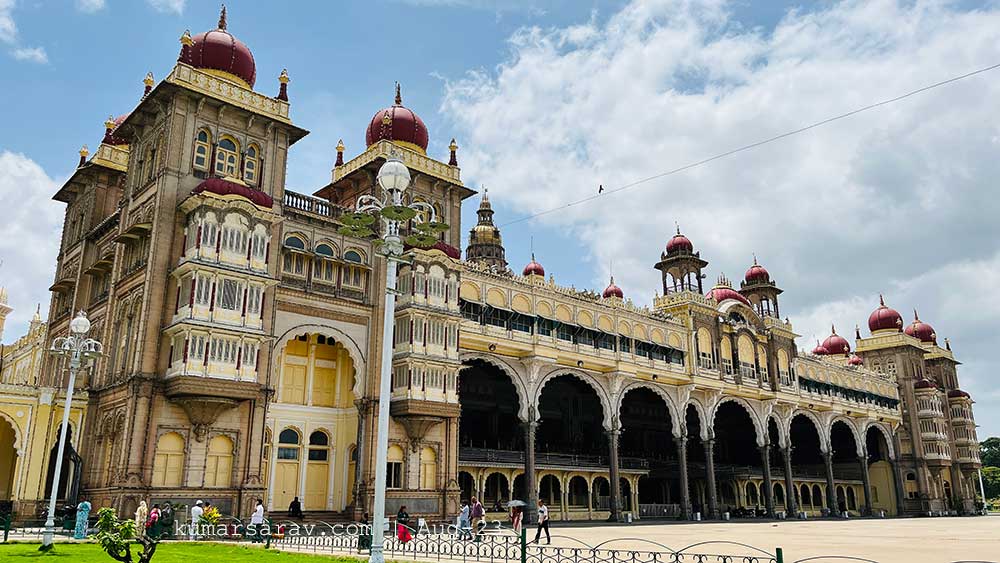
On each side of the central arch are two smaller arches, all held up by tall and strong pillars. Right above the central arch, you can’t miss a striking sculpture. It depicts Gajalakshmi, a goddess associated with good luck, wealth, and having plenty of good things. She’s shown with her trusty elephant companion.
As you enter the Palace, you’ll enter a world of intricate artwork and luxury. The doors are beautifully crafted, and there are large open spaces, elegant chandeliers, and ceilings with stunning stained glass that looks like colourful paintings.
The walls are covered with detailed paintings called frescoes, showing stories from India’s ancient epics. It’s like a vibrant history lesson displayed on the walls. All these ornate features inside highlight the incredible skills of local artists.
The Palace’s interior showcases the greatness of the Mysuru kings, and it truly feels royal and unique.
Notable Sights Within Mysore Palace
Stepping into the Mysore Palace is like taking a journey back in time. You’ll uncover the tales of a bygone era as you stroll through its intricate corridors and majestic courtyards.
Every corner and crevice of the Amba Vilas Palace carries the echoes of past kings and queens – their lives, victories, and struggles. Inside, you’ll find yourself in a living museum that bridges the gap between the present and the history of those who came before.
Captivating Features Within Mysore Palace
While exploring the Mysore Palace, make sure to discover these remarkable features:
Gombe Thotti or Doll’s Pavilion: A showcase of traditional dolls that tell their own stories.

Golden Howdah: Witness the Maharaja’s elephant seat made from 85 kilograms of gold.

Kalyana Mantap or Marriage Pavilion: An octagonal hall adorned with a stained glass ceiling, once the setting for grand ceremonies.
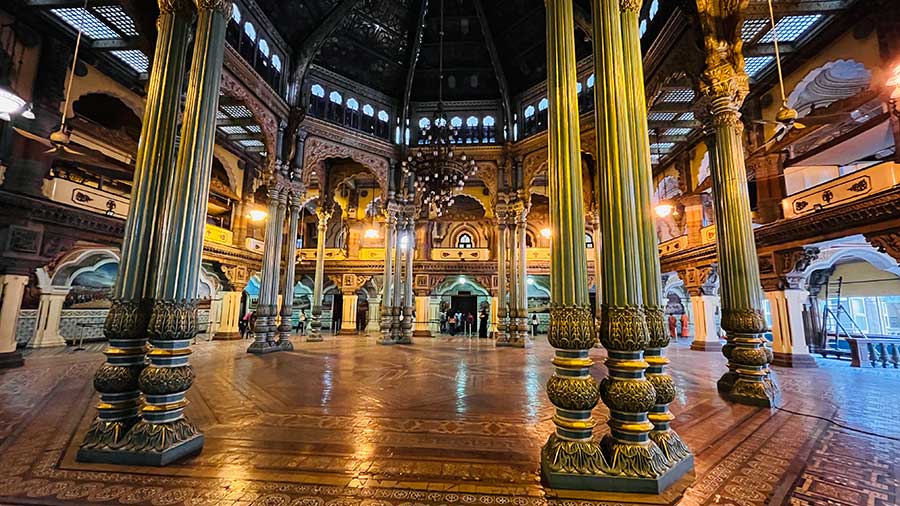
Public Durbar Hall: Step into this expansive hall where the Maharajas addressed the public.
Ambavilasa: Delight in the beauty of this exquisitely designed hall, once the venue for the Maharajas’ private audiences.
Elephant Gate or Ane Bagilu: The Palace’s main entrance is marked by a brass gate, symbolizing its regal stature.
Paintings of Dasara Procession: Admire depictions of vibrant Dasara processions that showcase the city’s lively festivities.
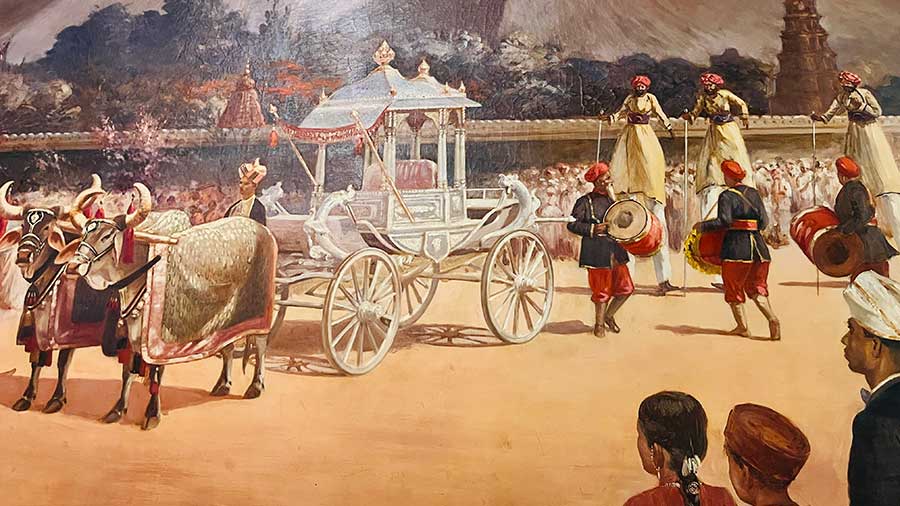
Portrait Gallery: Immerse yourself in a collection of valuable paintings and photographs that capture the essence of the Royal Family.
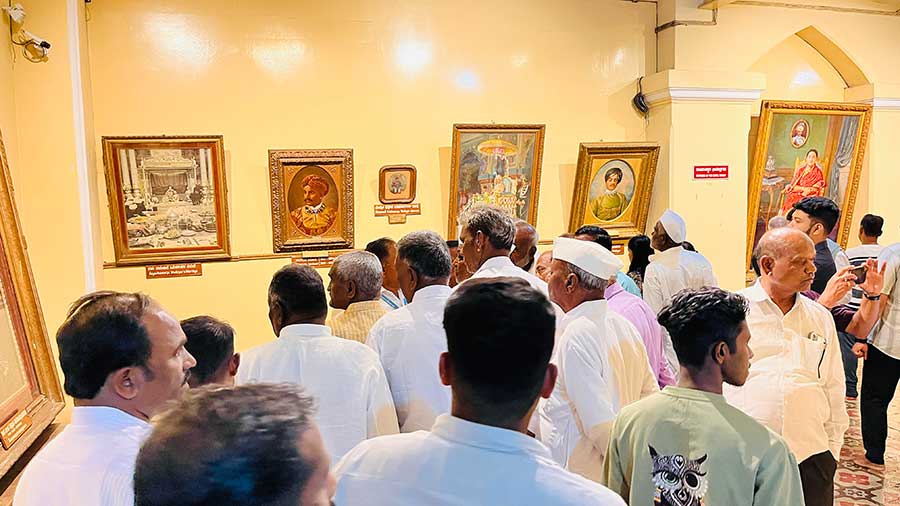
Casket Room: Explore the room housing the Royal Family’s treasured collections, each item a piece of history.

Wrestling Courtyard: Discover the courtyard that once echoed with the sounds of traditional wrestling matches.
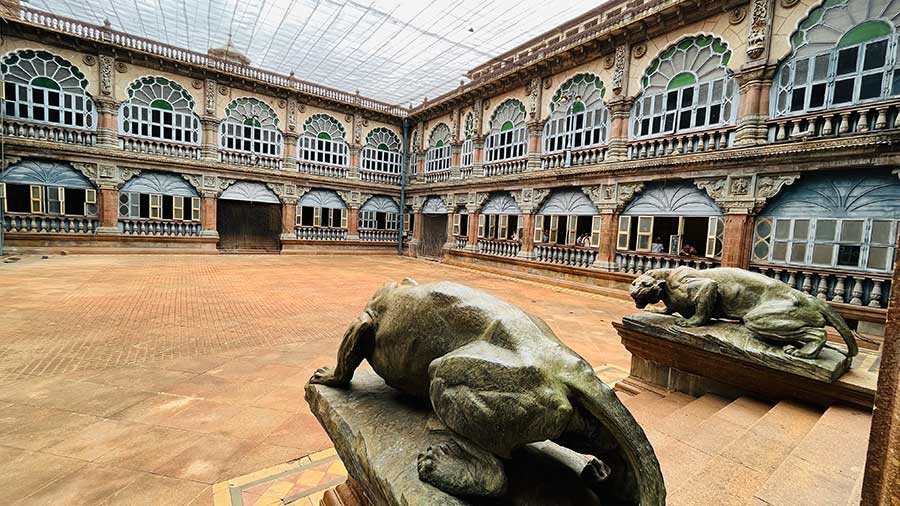
Temples Within Amba Vilas Palace Complex
Discover eight temples within Amba Vilas Palace grounds, adding spiritual depth to your visit. Explore and connect with their cultural significance.
Kodi Bhairavasvami Temple
The Kodi Bhairavasvami Temple is devoted to Shiva in the Bhairava form. Its name comes from its historical location.
Sri Lakshmiramana Swami Temple

The Sri Lakshmiramana Swami Temple, the city’s oldest, is found in the western part of the fort within the Palace. The temple holds significance as it hosted all the religious ceremonies for the coronation of Child Raja Krishnaraja Wadiyar III on June 30, 1799.
The Sri Shweta Varahaswamy Temple
The Sri Shweta Varahaswamy Temple is situated near the south gate. It follows the architectural style of the renowned Hoysala Empire, which dominated Karnataka from the tenth to the fourteenth centuries.
The Sri Trinayaneshvara Swami Temple
The Sri Trinayaneshvara Swami Temple, an ancient site predating Raja Wadiyar’s era, stands outside the Mysore fort beside Devaraya Sagar. The temple became part of the fort during Kanthirava Narasaraja Wadiyar and Dodda Devaraja Wadiyar’s reigns, coinciding with the fort’s expansion.
Sri Prasanna Krishnaswami Temple
The Mysore dynasty traces its lineage back to Sri Krishna of the Yadu Vamsa (Yadu Race) in the Mahabharata. Feeling the absence of a temple dedicated to Krishna, Krishnaraja Wadiyar III initiated the building of the Sri Prasanna Krishna Temple in 1825. The construction was finalized and marked by an inscription in 1829.
Kille Venkatramana Swamy Temple
During Tipu’s time, while the Mysore family resided in Srirangapatna, Queen Lakshmammanni’s concerns for the dynasty grew. In a dream, Lord Venkataramana instructed her to bring his statue from Balamuri and consecrate it in Mysore. By doing so, her dynasty would find salvation. She secretly retrieved the image, installed it in the temple, and devotedly worshipped it. This act was believed to have aided the family, restoring the Wadiyar dynasty after Tippu’s downfall.
Sri Bhuvaneshwari Temple
Sri Bhuvaneshwari Temple is north of the Palace Fort, aligning with the Varahaswamy temple in the south. Constructed by Sri Jayachamarajendra Wadiyar in 1951, the temple features an essential artefact: a copper Surya Mandala. This Mandala is believed to have been relocated from the Palace to the temple by His Highness Jayachamarajendra Wadiyar.
Sri Gayathri Temple
The Sri Gayatri Temple, positioned in the fort’s southeast corner as a direct counterpart to the Trinayaneshwara Swamy Temple, was built by Jayachamarajendra Wadiyar in 1953. Inside the temple, you’ll discover three shrines devoted to the revered deities Savithri, Gayathri, and Saraswathi.
Cultural Events
Mysore Palace serves as a cultural hub. Throughout the year, various festivals and events occur within its premises, offering a glimpse into the vibrant traditions and rituals that have shaped the region’s culture.
Sound and Light Program
The evening light and sound show is a must-see at Mysore Palace. It vividly showcases the rich 600-year history, culture, and traditions of the Wodeyar Dynasty, captivatingly presented for 45 minutes. Catch it from 7:00 pm to 8:00 pm on all days except Sundays and public holidays.
Mysore Palace Illumination
Mysore Palace comes alive with evening lights on Sundays, public holidays, and during the festive Dasara period. On weekdays, catch a brief illumination after the light and sound show, using 97,000 electric bulbs that transform the Palace into a spectacle.
Palace Lights Timings:
- Sundays, public holidays, and during Dasara – 7:00 pm to 7:45 pm
- Weekdays – 7:40 pm to 7:45 pm
- Tickets: Not required
Mysore Dasara Celebration
The Mysore Palace springs to life during the Dasara festival. Within the palace grounds, acclaimed artists grace a dedicated stage. A significant spectacle unfolds on the festival’s tenth day, Vijaya Dashami, as ornate elephants and lively floats commence a parade from the Palace.
The grandeur of Dasara takes centre stage in Mysore between September and October. It commemorates the triumph of the goddess Durga over the demon Mahishasura, symbolizing good prevailing over evil in Hindu mythology.
With roots in Srirangapatna from 1610 and a legacy continued in Mysore since 1799, this festival is steeped in history. Though celebrations have evolved, their significance remains woven into Mysore’s cultural fabric.
The Mysore Palace is a captivating treat for visitors, illuminated by over 96,000 lights throughout these festive months, creating a mesmerizing scene.
Mysore Palace is a photographer’s paradise

Mysore Palace is a haven for photography enthusiasts, providing a wealth of captivating subjects. From the interplay of light and shadow to the intricate carvings and the Palace’s majestic facade, it’s a treasure trove for enhancing travel memories.
Remember that there could be limitations on bringing professional photography equipment inside the Palace. Like me, you might find that using your smartphone is the best way to seize those beautiful moments.
Tip: Prioritize a Trustworthy Smartphone with Exceptional Camera and Battery Backup for Your Needs.
And thus, the story of Mysore’s enchanting treasures comes to a close. From the regal opulence of Amba Vilas Palace to the hidden gems tucked within its grounds, the city unveils a rich tapestry of history, culture, and art.
The grandeur of the Mysore Dasara festival, the serene temples, and the culinary delights all weave together to create an unforgettable experience. As you depart, may the echoes of Mysore’s past and the allure of its present linger in your memories, inspiring future journeys and adventures.
Explore other attractions near Mysore Palace:
- Enjoy a leisurely walk around Dodda Gadiyara and savour the charming surroundings.
- Indulge in art at the Jaganmohan Palace Art Gallery and Auditorium
- Immerse yourself in the vibrant Devaraja Market
- Experience wildlife wonders at Sri Chamarajendra Zoological Gardens
- Relax by Karanji Lake’s side amidst nature’s tranquillity.
- Admire the architectural marvel of Philomena Church
- Discover the captivating Mysore Railway Museum
- Dive into history at Jayalakshmi Vilas Complex Museum
Your adventure awaits!
Delightful Gastronomic Discoveries in Mysore
Mysore’s culinary scene is renowned, drawing travellers from afar to savour its delights. If you’re a vegan, don’t miss breakfast at Mylari restaurants in Nazarabad and Agrahara. For non-veg enthusiasts, locals highly recommend the original Hanumanthu Pulao. Indulge in Mysore’s culinary treasures!
Beyond Mysore Palace: Unveiling the City’s Splendors

As your journey of discovery begins at Amba Vilas Palace, remember that Mysore has so much more to offer. Whether you’re taking your time or have a tight schedule, planning ahead is critical, and platforms like Trip Advisor can be beneficial for making the most of your visit.
Happy exploring!











